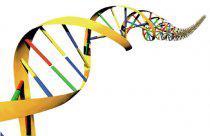 In November last year I was invited to participate in a panel discussion onthe role of DNA barcoding in conservation science. The discussion took place during the 4th International Barcode of Life Conference (which I didn’t actually attend) in Adelaide, and was hosted by that media-tart-and-now-director-of-the-Royal-Institution, Dr. Paul Willis.
In November last year I was invited to participate in a panel discussion onthe role of DNA barcoding in conservation science. The discussion took place during the 4th International Barcode of Life Conference (which I didn’t actually attend) in Adelaide, and was hosted by that media-tart-and-now-director-of-the-Royal-Institution, Dr. Paul Willis.
Paul has recently blogged about the ‘species’ concept as it relates to DNA barcoding, which I highly recommend. It also prompted me to write this post because now the video of the discussion is available online (see below).
Now, the panel was a bit of a funny set-up in a way – I was really one of the only ‘conservation biologists’ represented (Patrick O’Connor and Andy Lowe perhaps excepted), with the rest mainly made up of molecular people (Pete Hollingsworth, Bob Hanner, Karen James) – and I was told prior to the ‘debate’ that I was meant to be the contrarian (i.e., that there is no role for DNA barcoding in conservation).
Fundamentally, I don’t actually embrace the contrarian view on this one given that I see no reason why DNA barcoding can’t enhance or refine our conservation knowledge and skills. But the ‘debate’ did raise some important issues about technological advancements in the application of conservation science to real conservation.
I suppose that prior to getting stuck into the polemic I should define DNA barcoding for the uninitiated; it’s a basic technique that analyses short sequences of DNA with the sole purposes of identifying from which species they come. Imagine walking through the bush with a barcode scanner and pointing at random species you see and getting an instant identification read-out without actually knowing the species beforehand. You can see why it’s called ‘barcoding’ because it is like running products through the check-out to get instant price details.
Some of the advantages for conservation should be immediately obvious – ‘forensics’ of the wildlife or illegal timber trade can be enhanced by letting authorities know the origin and pathway of illegally imported or marketed animal or plant products. This can give bodies like customs and quarantine departments a big legal stick to smash poaching rings, et cetera. Another is determining the presence of a rare species that is difficult or impossible to survey – for example, identifying DNA fragments of rare fish in samples of river water. Once identified using DNA barcoding, a legal argument to preserve that habitat on the basis of threatened wildlife legislation can be made without the expense and uncertainty of traditional wildlife surveys.
I suppose the main point of contention about DNA barcoding is that it merely refines our capacity to survey species we probably already know are in trouble. I submitted during the discussion that we could probably kill every single conservation biologist in the world and not really handicap ‘conservation implementation’ in any major way because we have the main aspects of the science sorted (fragmentation is bad; more habitat area = more species; climate change is bad; invasive species are bad; too few individuals is bad; small populations tend to go extinct; drivers of extinction synergise to make things worse – see full list on Conservation Classics). The principal conservation science discoveries have been made; now we need to manage the resource consumption of 7 billion humans more than anything else. You can also read more about conservation science ‘mucking around the edges‘ in a previous post here on CB.
Another potentially questionable application of barcoding to conservation is that it merely tells us if something is there, not how many or in what state. With a simple binary output, we lack some essential information regarding the value of an area based on mere presence/absence. Certainly we do now do area prioritisation based largely on presence/absence data, but how many more cryptic species identifications do we need to prioritise habitats for preservation?
Those somewhat philosophical beefs aside, I’m still very much in support of the concept of quantifying species better than the somewhat subjective and categorical binomial genus-species system we currently use. I’m also excited by the prospect of using DNA barcoding to quantify ecosystem health better by measuring soil and water microbia composition, and perhaps even starting to get a handle on soil fungus diversity. If we can even improve DNA barcoding to become ‘q-barcoding’ that quantifies relative abundance in addition to identification, we’ll really have a massively important tool for measuring ecosystem and species health.
I’ll be interested in CB readers’ opinions on the subject.
CJA Bradshaw
-34.917731 138.603034
